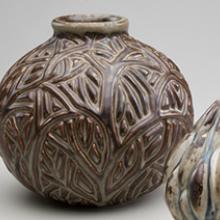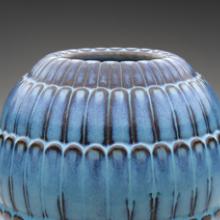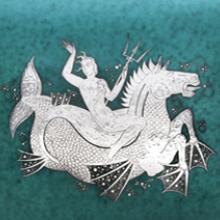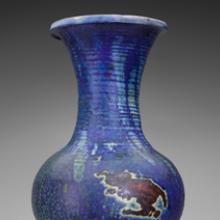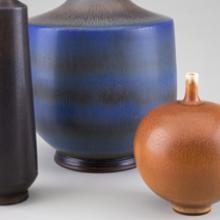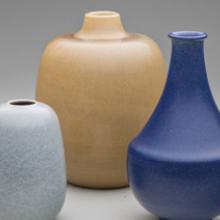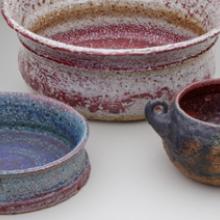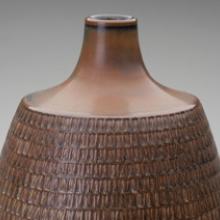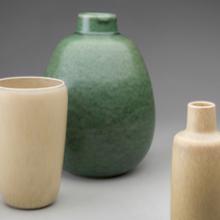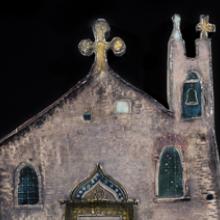Terminal 2
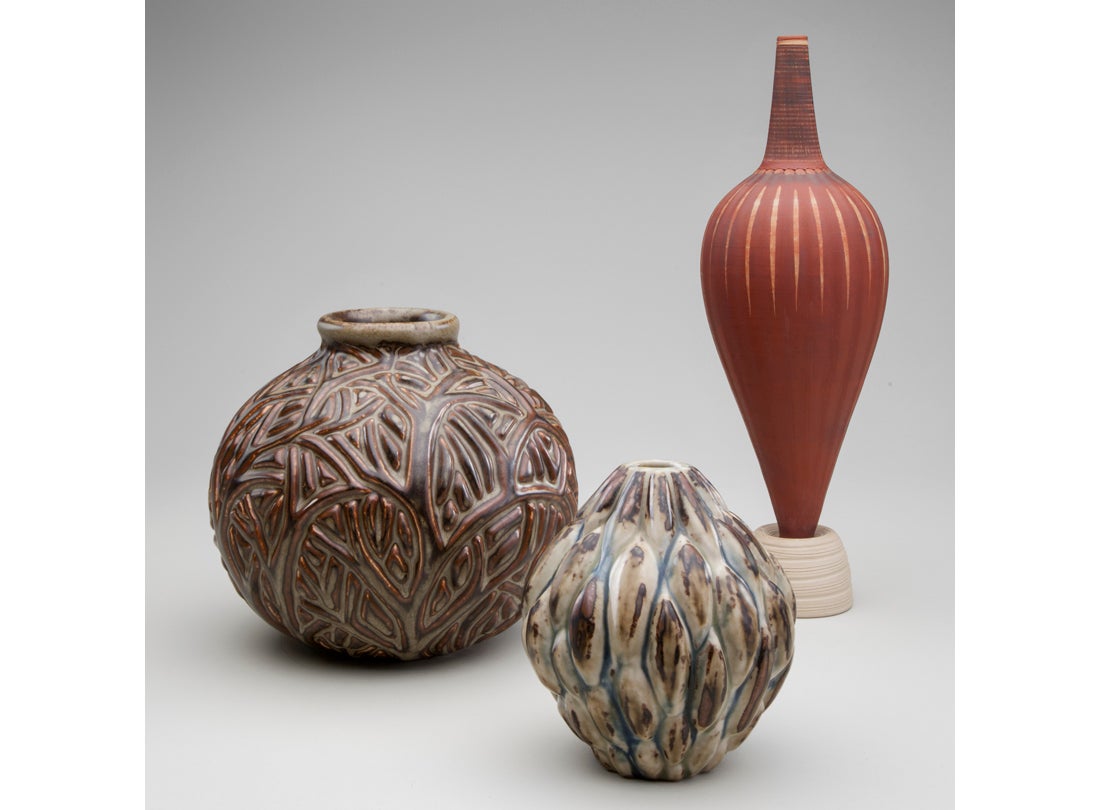

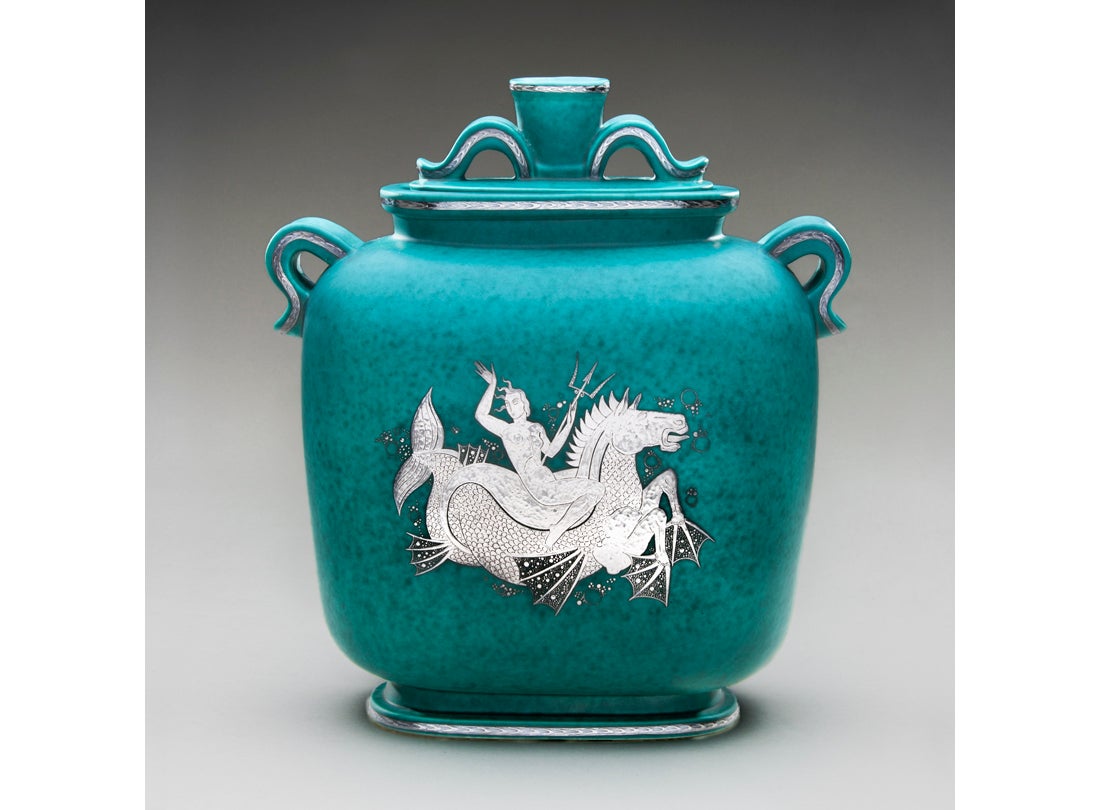
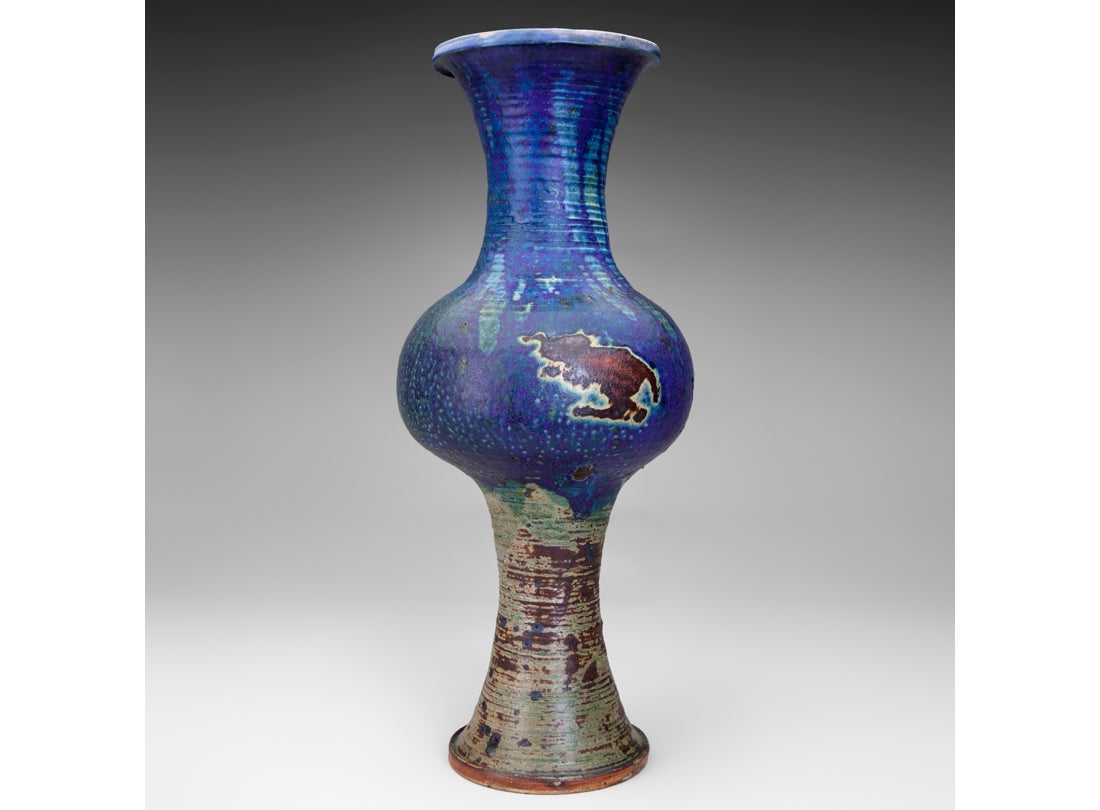


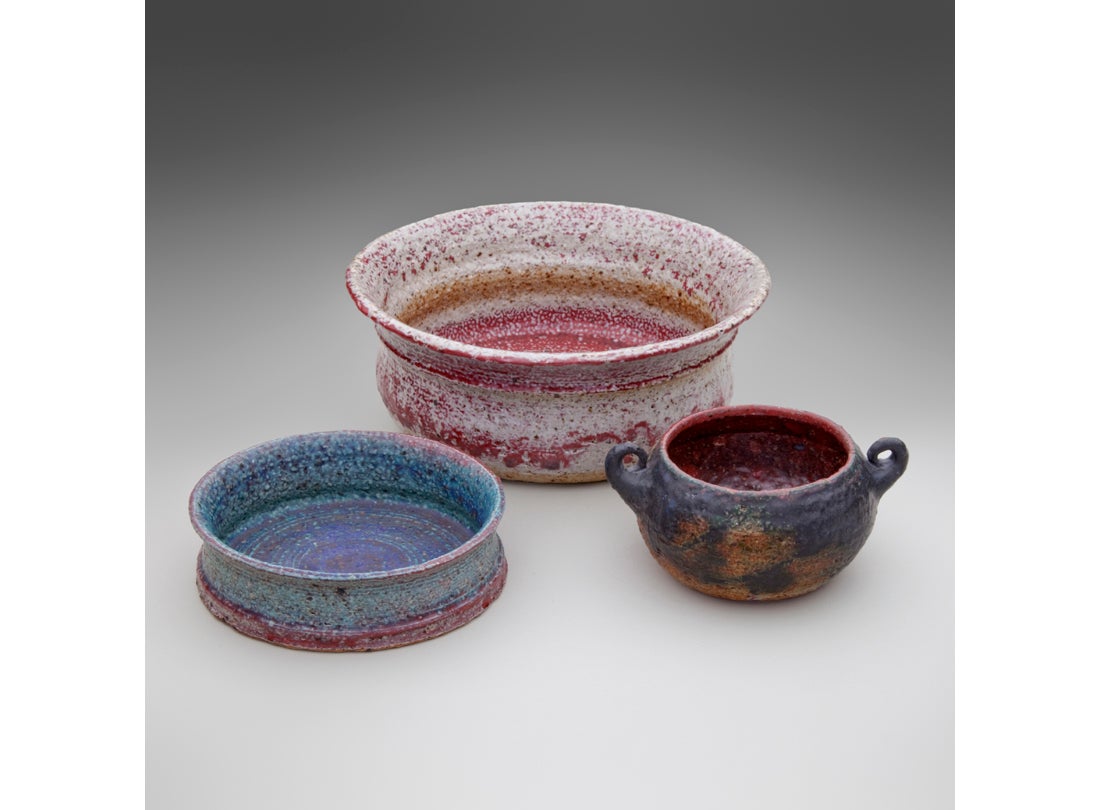

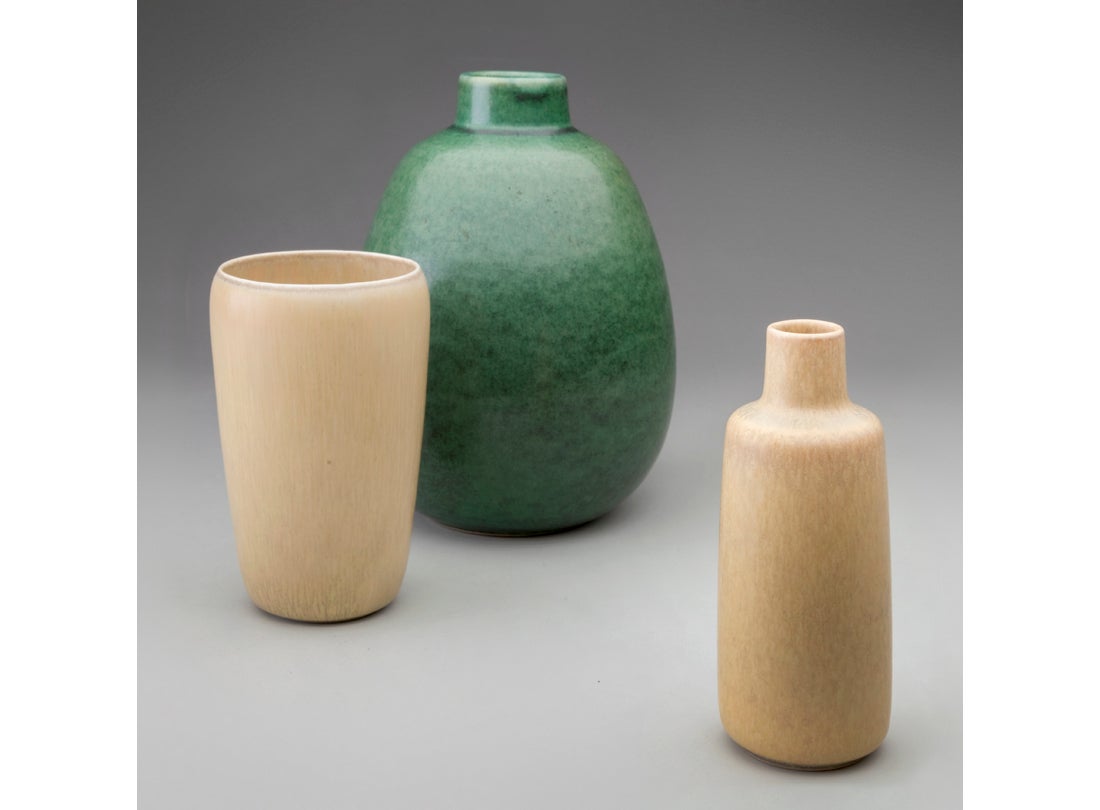
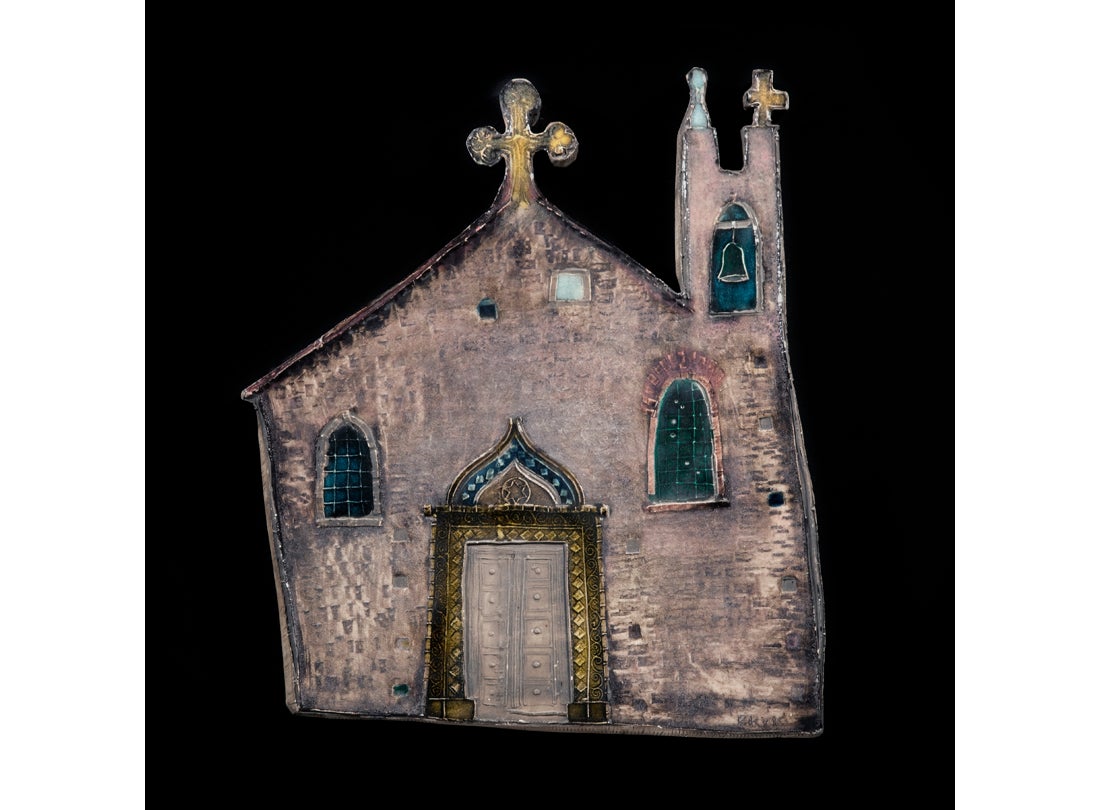
Vases c. 1950
Axel Salto (1889–1961)
Royal Copenhagen, Denmark
ceramic, glaze
Collection of Sid and Terry Garrison
L2011.2702.011, L2011.2702.013
Axel Salto (two piece on left), a remarkable innovator in the field of ceramics, was trained as a graphic artist and also enjoyed a lengthy career as a painter, illustrator, and designer of jewelry and metalware. After exploring new techniques with master ceramicist Carl Halier (1873–1948), Salto was recruited by Royal Copenhagen in 1934 to develop his organic forms. Salto applied special color effects by letting the glazes flow over and between the nodules and through the grooves of the surfaces of many of his vases. His pieces are often suggestive of fruit or growing plants as Salto explained: “These naturalistic models were worked into my ceramic pieces in such a way that, without obtruding themselves as copies of nature, they were made to inhabit, almost covertly, the ceramic material. My pieces thus, through their ability to recall something once seen or sensed in nature, release pleasure in the spectator.”
Vase 1944–47
Wilhelm Kåge (1889–1960)
Gustavsberg, Sweden
ceramic, glaze
Collection of Sid and Terry Garrison
L2011.2702.018
For Wilhelm Kåge, “ceramics was a universe, and life existed in order for him to discover and artistically express its dizzying possibilities,” wrote the design specialist Arthur Hald. One of Scandinavia’s most important designers, Kåge trained as a painter and graphic designer. He gained recognition as a poster designer before being recruited by the Gustavsberg ceramics factory in 1917. His appointment came as a direct result of the Swedish Society of Craft and Industrial Design’s campaign to persuade manufacturers to employ artists in order to improve the design of everyday objects. Kåge had a tremendous impact on Swedish ceramics. He designed successive lines of beautiful, functional dinnerware, and like many of his contemporaries, he also produced remarkable studio pottery. His highly regarded Farsta series, first introduced in the 1920s, is characterized by heavier, incised forms that are masterfully glazed in a subtle color palette reflecting Kåge’s origins as a painter.
Vessel c. late 1930s
Wilhelm Kåge (1889–1960)
Gustavsberg, Sweden
ceramic, glaze, silver
FLM No. 2951
L2011.2701.064 a,b
Kåge’s Argenta, one of his most famous lines, was introduced at the Stockholm Exhibition of 1930. The green-glazed ceramics emulated the look of oxidized bronze. The Argenta line, with its decorative silver overlay, displays the strong influence of the Art Deco style on Scandinavian design during the 1930s.
Vase 1950s
Kyllikki Salmenhaara (1915–1981)
Arabia, Finland
ceramic, glaze
FLM No. 2992
L2011.2701.073
Kyllikki Salmenhaara, Finland’s “Queen of Clay” has obtained mythical status in her home country, and her work is also recognized internationally. She is revered for her extremely balanced and restrained forms. Salmenhaara began working at Arabia in 1947 where she perfected the clay known as chamotte, which is a mixture of rough, grey-brown clay mixed with burnt and crushed porcelain or stoneware. Her specialty as a thrower was in the creation of large, impressive vases made from several smaller sections thrown in advance. In 1960, her career came to a tragic halt when a rusty blade left in the clay she was using damaged her right hand. For more than a year, she was unable to throw. Although she recovered, her hand was permanently damaged. After this traumatic event, she taught ceramics in Taiwan from 1961 to 1963. Salmenhaara then returned to Finland in 1963, where she worked as director and lecturer at the Institute of Applied Arts at the Atheneum in Helsinki until her death in 1981.
Vases 1948–1960s
Berndt Friberg (1899–1981)
Gustavsberg, Sweden
ceramic, glaze
Collection of Sid and Terry Garrison
L2011.2702.036, L2011.2702.041, L2011.2702.034
Berndt Friberg first apprenticed as a thrower at the Höganäs-Billesholms stoneware factory in Sweden from 1915 to 1918. After ten years as a thrower for Wilhelm Kåge, Friberg began designing his own pottery at the Gustavsberg ceramics factory in 1944. He continued to work at the factory until his death in 1981. Friberg’s sensitive treatment of his material and expert craftsmanship set an important standard in the history of studio ceramics. His hand-thrown ceramics were awarded gold medals at the Milan Triennale in 1947, 1951, and 1954. He often used soft greens, pale ochres, and dusky blues for his color palette. Friberg borrowed from traditional Chinese teabowl forms to create distinctively Scandinavian ceramics. The “hare’s fur” technique of allowing the glaze to run during firing is particularly effective in his ochre-colored ceramics, resulting in beautiful, striated surfaces and interesting patterns at the bases of the bowls where the glazing pools.
Vases c. 1950s
Erich (1898–1972) and Ingrid Triller (1905–1982)
Tobo, Sweden
ceramic, glaze
Collection of Sid and Terry Garrison
L2011.2702.026, L2011.2702.027, L2011.2702.028
Erich and Ingrid Triller met at the State Ceramics Professional School in Germany and later studied ceramics under the master potter Otto Lindig at the Bauhaus workshop. In 1935, the couple moved to Ingrid’s native Sweden and established the Tobo studio where they created some of the finest stoneware ever produced in Scandinavia. Sweden’s King Gustavus VI Adolphus acquired many of the Triller’s pieces for his ceramics collection.
The couple’s collaboration at Tobo ended only upon Erich Triller’s death in 1972.
Bowls 1960s
Raija Tuumi (b. 1923)
Arabia, Finland
ceramic, glaze
FLM No. 1529, L2011.2701.025, FLM No. 2904, L2011.2701.040, FLM No. 2903, L2011.2701.039
Raija Tuumi graduated from the Ceramics Department at the University of Art and Design in Helsinki in the late 1940s and began working at Arabia in 1950. Tuumi made heavy, simply thrown forms, which she combined with crude, uneven glazes. Many of her hand-thrown pots have rows of tiny perforations that let in light. These rustic characteristics are what distinguish her pieces from others. After leaving Arabia in the 1970s, for a few years, Tuumi established her own studio, Jousapot.
Vessel 1962
Stig Lindberg (1916–82)
Gustavsberg, Sweden
ceramic, glaze
Collection of Sid and Terry Garrison
L2011.2702.040
Bottle c. 1950s
Saxbo, Denmark
Eva Stær-Nielsen (1911–1976)
ceramic, glaze
Collection of Sid and Terry Garrison
L2011.2702.023
Vase c. 1950s
Saxbo, Denmark
Eva Stær-Nielsen (1911–1976)
ceramic, glaze
Collection of Sid and Terry Garrison
L2011.2702.024
Vase c. 1950s
Saxbo, Denmark
ceramic, glaze
Collection of Sid and Terry Garrison
L2011.2702.039
Nathalie Krebs established the Saxbo pottery studio when her partner Gunnar Nylund left their workshop in Herlev, Denmark, in the early 1930s to become the artistic director at Rörstrand ceramics factory in Sweden. Krebs employed her training as a chemical engineer to perfect her glaze formulations. Under Krebs’ direction, consistent production of exquisitely glazed, simple forms earned Saxbo a reputation as one of the finest independent workshops in Scandinavia from the 1930s to the 1960s. When Krebs retired in 1968, she destroyed the molds, designs, and glaze formulations to effectively end the company and prevent the production of any work that might compromise Saxbo’s esteemed reputation.
Church c. 1950s–60s
Rut Bryk (1916–¬99)
Arabia, Finland
ceramic, glaze
FLM No. 322
L2011.2701.014
Rut Bryk studied graphic design at the School of Arts and Crafts in Helsinki. She was married to the renowned Finnish industrial designer Tapio Wirkkala (1915–1985). Bryk began working at Arabia in 1942, where she embraced the medium of clay. Although the material was new to her, she quickly gained recognition as a ceramic artist. Her background in graphic design and illustration is clearly evident in her distinctive work. Bryk told simple stories in clay. Her decorative wall plaques display a mystical world of imaginative flowers, figures, animals, and dwellings. She used thick, brightly colored, glass-like glazes on her faience (glazed earthenware) pieces. Bryk remained affiliated with the Arabia ceramic factory until 1992.
